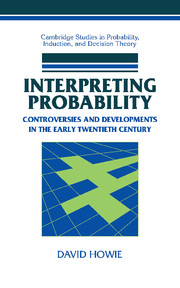Book contents
- Frontmatter
- Contents
- Acknowledgments
- 1 Introduction
- 2 Probability up to the Twentieth Century
- 3 R.A. Fisher and Statistical Probability
- 4 Harold Jeffreys and Inverse Probability
- 5 The Fisher–Jeffreys Exchange, 1932–1934
- 6 Probability During the 1930s
- 7 Epilogue and Conclusions
- Appendix 1 Sources for Chapter 2
- Appendix 2 Bayesian Conditioning as a Model of Scientific Inference
- Appendix 3 Abbreviations Used in the Footnotes
- Bibliography
- Index
6 - Probability During the 1930s
Published online by Cambridge University Press: 07 July 2009
- Frontmatter
- Contents
- Acknowledgments
- 1 Introduction
- 2 Probability up to the Twentieth Century
- 3 R.A. Fisher and Statistical Probability
- 4 Harold Jeffreys and Inverse Probability
- 5 The Fisher–Jeffreys Exchange, 1932–1934
- 6 Probability During the 1930s
- 7 Epilogue and Conclusions
- Appendix 1 Sources for Chapter 2
- Appendix 2 Bayesian Conditioning as a Model of Scientific Inference
- Appendix 3 Abbreviations Used in the Footnotes
- Bibliography
- Index
Summary
INTRODUCTION
Jeffreys was not alone in advocating inverse probability. Indeed, Fisher was unusual among British statisticians in attacking it. According to Keynes, use of the Principle of Insufficient Reason was widespread and unquestioned during the 1920s. Keynes's Treatise on Probability further persuaded philosophers and scientists of the force of the epistemic interpretation. The criticisms of the method that had surfaced in the nineteenth century had led not to its abandonment but to the recognition that it was limited and must be treated cautiously. Most mathematical textbooks continued to include inverse probability, though they rarely showed applications to real situations. Sandy Zabell quotes a revealing passage in which the Harvard mathematician Julian Coolidge wearily conceded that despite Bayes's defects, it was the “only thing we have to answer certain important questions which do arise in the calculus of probabilities … Therefore we use Bayes' formula with a sigh, as the only thing available under the circumstances.”
Neither Jeffreys nor Fisher was able to convince the other of his interpretation of probability. Yet the respect, often grudging, accorded the inverse method gradually subsided during the 1930s, and the frequency interpretation – with Fisher's associated approach to scientific experimentation – gained hold. In the previous chapter I argued that each of Fisher's and Jeffreys's methods was coherent and defensible, and that the clash between them was not a consequence of error on one side.
Information
- Type
- Chapter
- Information
- Interpreting ProbabilityControversies and Developments in the Early Twentieth Century, pp. 171 - 221Publisher: Cambridge University PressPrint publication year: 2002
